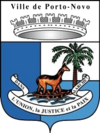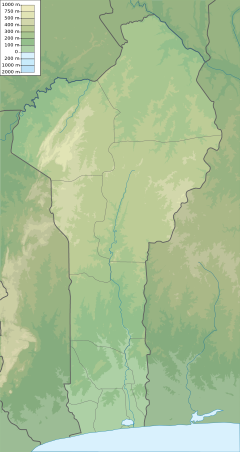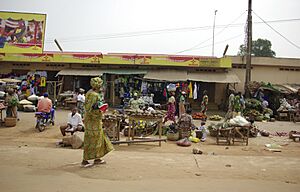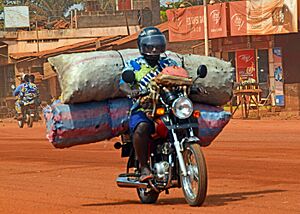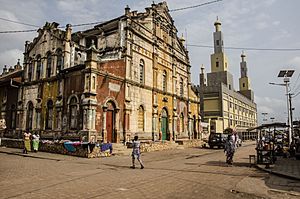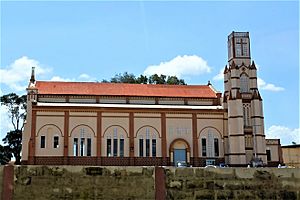Porto-Novo facts for kids
Quick facts for kids
Porto-Novo
Xɔ̀gbónù
Hogbonu, Àjàṣẹ́
|
|||
|---|---|---|---|
|
Capital city and commune
|
|||
|
Skyline, Grande Mosquee Porto-Novo, Porto Novo Cathedral, Pirogues sur lagune de Porto-Novo, Vue d'une entrée de la Grande mosquée, La statue du roi Toffa 1er, Ouando Market, Jardin des plantees et de la nature, Charles de Gaulle stadium
|
|||
|
|||
| Country | |||
| Department | Ouémé | ||
| Established | 16th century | ||
| Area | |||
| • Capital city and commune | 110 km2 (40 sq mi) | ||
| • Metro | 110 km2 (40 sq mi) | ||
| Elevation | 38 m (125 ft) | ||
| Population
(2013)
|
|||
| • Capital city and commune | 264,320 | ||
| • Density | 2,400/km2 (6,220/sq mi) | ||
| Time zone | UTC+01:00 (West Africa Time) | ||
| • Summer (DST) | (Not Observed) | ||
Porto-Novo is the official capital city of Benin, a country in West Africa. Its name means "New Port" in Portuguese. It is also known by its local names, Hogbonu and Ajashe.
Porto-Novo is located on an inlet of the Gulf of Guinea in the southeastern part of Benin. It covers an area of about 110 square kilometers (42 square miles). Even though it's the official capital and where the national law-making body meets, the larger city of Cotonou is where most government offices are found.
Contents
What's in a Name?
The name Porto-Novo comes from the Portuguese words for "New Port." This name is still used in French, which is the main language in Benin today.
A Look at History
Porto-Novo was once part of the powerful Oyo Empire, which was a Yoruba kingdom. The Oyo Empire protected Porto-Novo from the neighboring Fon, who were growing stronger. The Yoruba people are still one of the main groups living in the city today. The city was originally called Ajashe by the Yorubas and Hogbonu by the Gun.
Around the 1600s, a group led by Te-Agbalin moved to the Ajashe area. In 1730, a Portuguese explorer named Eucaristo de Campos gave the city the name "Porto-Novo." It became an important port for the trade of enslaved people across the Atlantic Ocean.
In 1861, the British attacked the city. This led the Kingdom of Porto-Novo to accept protection from France in 1863. However, the nearby Kingdom of Dahomey didn't like France's involvement, and a war started. By 1883, Porto-Novo became part of the French colony of Dahomey. In 1900, it was made the capital of Dahomey.
The kings of Porto-Novo continued to rule, even under French control, until the last king, Alohinto Gbeffa, passed away in 1976. Many Afro-Brazilians, who were descendants of enslaved people, came back to Africa and settled in Porto-Novo after slavery ended in Brazil. You can still see Brazilian influences in the city's buildings and food.
During French rule, many people moved across the border to British-ruled Nigeria. They did this to avoid difficult rules, military service, and forced labor. Because of this history and the city's closeness to Nigeria, many people in Porto-Novo have connections to both countries.
City's Economy
The area around Porto-Novo is known for producing palm oil, cotton, and kapok (a type of fiber). In 1968, oil was found off the coast, and it has been an important export since the 1990s. The city also has a factory that makes cement. You can find a branch of the Banque Internationale du Bénin, a big bank, and the busy Ouando Market here.
Getting Around
Porto-Novo has a train system called Bénirail. For getting around the city, many people use privately owned motorcycle taxis called zemijan. The city is about 40 kilometers (25 miles) from Cotonou Airport, which has flights to other cities in West Africa and Europe.
Who Lives Here?
In 2013, Porto-Novo had a population of 264,320 people. Most residents are from the Yoruba and Gun ethnic groups. There are also people from other parts of Benin and from neighboring Nigeria.
Here's how the population has grown over the years:
- 1979: 133,168
- 1992: 179,138
- 2002: 223,552
- 2013: 264,320
Geography and Climate
Porto-Novo has a tropical savanna climate. This means it's usually hot and humid. It has two rainy seasons: a long one from March to July and a shorter one in September and October. The city is located in an area called the Dahomey Gap, which makes it drier than other places close to the equator.
| Climate data for Porto-Novo | |||||||||||||
|---|---|---|---|---|---|---|---|---|---|---|---|---|---|
| Month | Jan | Feb | Mar | Apr | May | Jun | Jul | Aug | Sep | Oct | Nov | Dec | Year |
| Daily mean °C (°F) | 27 (81) |
28 (82) |
28 (82) |
28 (82) |
27 (81) |
26 (79) |
25 (77) |
25 (77) |
25 (77) |
26 (79) |
27 (81) |
27 (81) |
26 (79) |
| Average rainfall mm (inches) | 23 (0.9) |
34 (1.3) |
86 (3.4) |
127 (5.0) |
215 (8.5) |
370 (14.6) |
129 (5.1) |
44 (1.7) |
89 (3.5) |
140 (5.5) |
52 (2.0) |
16 (0.6) |
1,325 (52.1) |
City Sections
Porto-Novo is divided into five main areas, called arrondissements:
- 1st arrondissement
- 2nd arrondissement
- 3rd arrondissement
- 4th arrondissement
- 5th arrondissement
Culture and Attractions
Porto-Novo has many interesting places to visit:
- The Porto Novo Museum of Ethnography has a large collection of Yoruba masks. It also shows the history of the city and Benin.
- King Toffa's Palace, also called the Musée Honmé, is now a museum. It gives you a peek into the lives of African royalty. This palace is being considered for the UNESCO World Heritage list.
- Jardin Place Jean Bayol is a big public square. It features a statue of the first King of Porto-Novo.
- The Da Silva Museum shares the history of Benin. It focuses on the lives of Afro-Brazilians who returned to Africa.
- The palais de Gouverneur (governor's palace) is where Benin's national legislature meets to make laws.
- The Isèbayé Foundation is a museum about Voodoo and the history of Benin.
Music Scene
A special kind of music called Adjogan comes from Porto-Novo. It's played using an alounloun. This is a stick with metal rings that jingle when the stick is beaten. The alounloun was traditionally used to honor the King and his officials. This music is also played in the city's Roman Catholic churches, but with a cross symbol instead of the royal bird crest.
Sports Venues
The city has two main football stadiums: the Stade Municipal and the Stade Charles de Gaulle.
Places to Worship
Porto-Novo has many places of worship for different faiths. There are many Christian churches, including Roman Catholic Diocese of Porto Novo (Catholic Church), Protestant Methodist Church in Benin, Celestial Church of Christ, and others. There are also Muslim mosques, with the Grand Mosque being very notable. You can also find several Voodoo temples in the city.
Famous People from Porto-Novo
Many notable people have come from Porto-Novo, including:
- Alexis Adandé, an archaeologist
- Anicet Adjamossi, a football player
- Géraldine Faladé, a journalist
- Kamarou Fassassi, a politician
- Romuald Hazoume, an artist
- Samuel Oshoffa, who started the Celestial Church of Christ
- Claudine Talon, the First Lady of Benin (since 2016)
- Marc Tovalou Quenum, a lawyer and writer
- Paulin Soumanou Vieyra, a director and author
- Gaston Zossou, a politician
See also
 In Spanish: Porto Novo para niños
In Spanish: Porto Novo para niños












